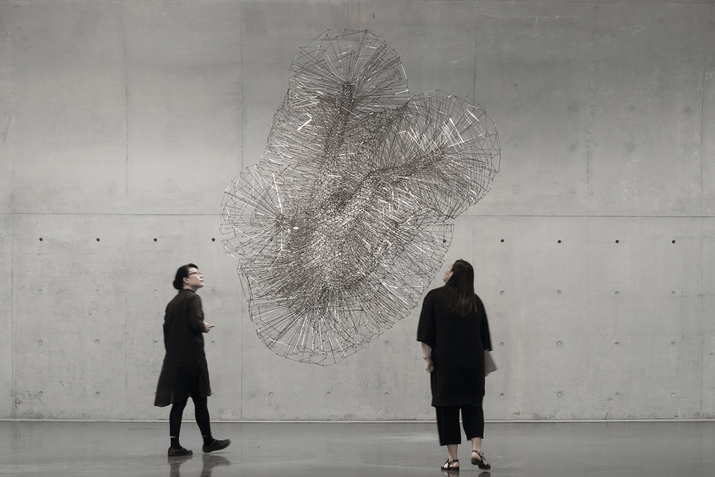-
From Current Issue
-
- Editor’s Letter Fire in the Heart
- Reviews I Gusti Ayu Kadek Murniasih
- Reviews 11th Seoul Mediacity Biennale: “One Escape at a Time”
- Dispatch Networked China
- One on One Monira Al Qadiri on Yukio Mishima
- Essays The rise of independent art spaces in pandemic-era Shanghai
- Features Tuan Andrew Nguyen
- Table of Contents
- Web Exclusives
- Archive
- Subscribe

R
E
V N
E
X
T
ANTONY GORMLEY, Critical Mass II, 1995, cast iron, 60 life-size elements, dimensions variable. Courtesy Antony Gormley Studio, London; and Long Museum, Shanghai.
Antony Gormley’s first-ever major exhibition in China, “Still Moving,” mounted at Long Museum, might turn out to be the finest exhibition that the institution has presented since its opening in 2014 in Shanghai’s burgeoning West Bund area. There are a number of reasons for this, but the chief factor is Gormley’s brilliant, flawless restraint in the placement of his works throughout the museum’s ground floor.
Long Museum’s cast concrete structure, with its vaulted interiors, greatly interested Gormley when the institution invited him to exhibit in Shanghai. He saw the compound as a series of unified forms—not unlike the results of the sculptor’s own casting process—or “buildings that are like skulls,” as Gormley stated during an afternoon talk prior to the show’s opening. The artist quite literally humanizes the first floor spaces while fulfilling one of his fundamental tenets as an artist to make “sculpture that interrogates its environment.”
The exhibition’s centerpiece is the sprawling installation Critical Mass II (1995), consisting of 60 life-sized, cast-iron figures in 12 fixed positions: fetal, squatting, sitting, kneeling, standing, with several figures suspended by their feet at varying heights and bound by heavy industrial cable. Upon entering the museum’s main gallery space, a long diagonal arrangement of these figures suggests an illustrated timeline charting human evolution, while others are scattered throughout the space, some kneeling or couching against the walls, isolated or off by themselves. We are also confronted by a disconcerting pile of bodies as if waiting to be dumped into a mass grave.
The imperfections in the casts—from the original plaster body casts to the sand moulds and metal pourings—are visibly retained as surface evidence of the work’s process and industrial genesis. While Critical Mass was made some 20 years ago in a direct response to a specific site—an old tram storage station in Vienna—the work continues to evoke a powerful sense of vulnerability, loss and anonymity. Gormley refers to Critical Mass as an “anti-monument evoking the victims of the 20th century” that “communicates the useless status of sculpture itself.” But knowing the work’s origin, it isn’t difficult to think of trains departing for Auschwitz or Dachau.
Four suspended stainless steel sculptures are included in the show, Feeling Material XXXVI, Freefall III, Flare II (all 2008), and the more recent Freeze III (2012). These works are painstakingly welded by hand, crafted out of 2 mm stainless steel bar or 5 mm mild steel bar, creating open, web- or cocoon-like forms that function like drawings in midair. Each play off a sense of weightlessness, dematerializing mass yet retaining fullness and volume. Freefall IIIand Flare II, for example, are both complex constellations where an intricate wiry body form is encased and serves as the work’s structural core.
A new work, Passage II (2017), exemplifies Gormley’s thinking about how sculpture can be both object and experience. Constructed out of 6 mm weathering steel, the work is a 15.5-meter-long tunnel completely closed off at one end and modeled after the shape of a boxy, hard-edge, geometric standing figure. The open entranceway into the tunnel, as if entering the interior of a body, is average human height and quickly leads into near total darkness—and to the unknown. The tunnel walls, if one bangs on them (which visitors are permitted to do), resonates with a low reverberating tone. Some may see this journey as therapeutic, but it is not one meant for those who are claustrophobic or frightened by the dark.
If there were any missteps in this exhibition, it might be the presentation of Breathing Room IV [Rio] (2012), one of Gormley’s abstract architectural environments. Constructed from photo-luminescent, blue cuboid frames that form walk-through passageways, the work functions in ten-minute intervals: ten minutes of darkness followed by an intense 40-second blast of light to recharge and reactivate the structures. Object as experience has been one of Gormley’s central ideas, but this work falls too easily into the realm of throwbacks to the 1960s or ’70s, when a handful of artists made names for themselves by working with space and light. It didn’t hold the same impact as seeing one of his solitary figures standing precariously close to the edge of a distant rooftop, and failed to carry the visceral power or poetic engagement with the static body in space.
Antony Gormley’s “Still Moving” is on view at Long Museum, Shanghai, until November 26, 2017.
To read more of ArtAsiaPacific’s articles, visit our Digital Library.








